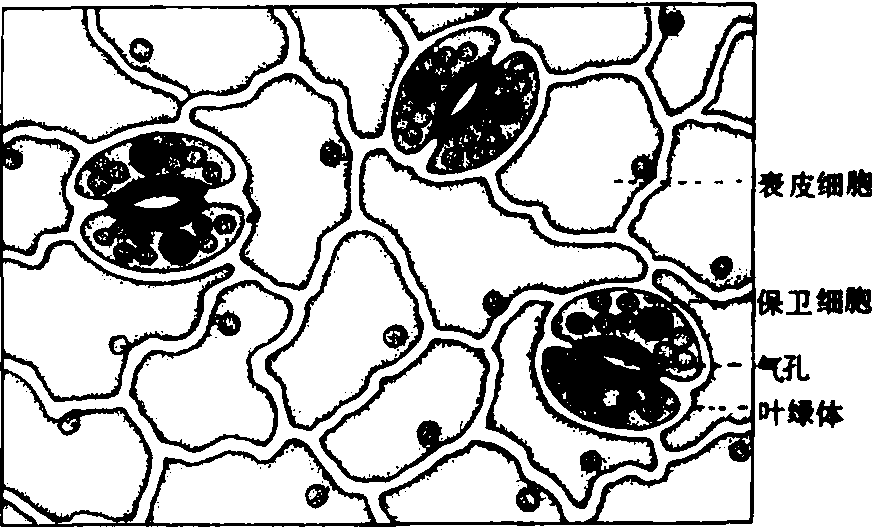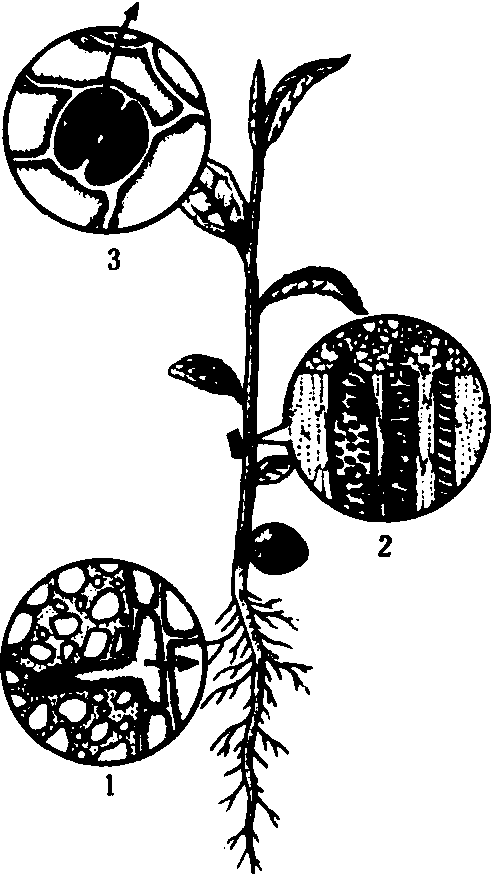茶树蒸腾作用transpiration of teaplant
水分以水蒸汽形式从茶树体内通过表皮、气孔散失到大气的过程。蒸腾根据部位的不同, 可分为茎枝上的皮孔蒸腾、叶片的角质蒸腾和气孔蒸腾。皮孔蒸腾只占总蒸腾量的0.1%左右,茶树幼叶角质蒸腾较老叶角质蒸腾高, 其蒸腾量可达总蒸腾量的30~50%。气孔蒸腾是茶树蒸腾作用的主要方式, 涉及气孔及其对蒸腾作用的调节作用、内外因素对蒸腾作用的影响、调节蒸腾作用, 维持茶树水分平衡等方面的内容。
茶树气孔 茶树叶片气孔的大小、数目, 视品种、叶位、叶龄和环境条件的不同有很大差异。据测, 大叶种气孔密度约100个/毫米2左右, 以至150~180个/毫米2; 中小叶种约200~260个/毫米2。福鼎大白茶在安徽种植,气孔密度约150~200个/毫米2。气孔长15~18微米, 宽5~9微米; 中度遮荫下, 气孔密度约80~100个/毫米2, 气孔孔隙增大。黄山群体种气孔密度约260个/毫米2, 气孔开度最大时面积约100微米2;中度遮荫下,气孔密度约为200个/毫米2, 气孔开度最大时面积约150微米2。幼叶气孔密度几乎是成叶的两倍。
茶树叶片的气孔只分布在下表皮。气孔是由两个肾形的保卫细胞构成的(图1)。内含叶绿体, 能进行光合作用, 保卫细胞内还含有磷酸化酶。保卫细胞内壁厚、外壁薄, 表皮细胞则不具备这些特征。气孔开闭是由于保卫细胞压力势的变化引起的。在光照下,保卫细胞叶绿体进行光合作用,糖类和无机离子增加,水势降低, 保卫细胞吸水, 压力势增高, 气孔张开:在暗中, 气孔关闭或开张度缩小。低浓度CO2使气孔张开:高浓度CO2使气孔关闭。茶树强烈蒸腾时, 保卫细胞失水多,气孔开度缩小。温度也影响气孔开度,在25~30℃时, 气孔开度最大。在通常情况下, 环境因子的综合作用决定气孔开度。依气孔开度的变化, 以调节蒸腾作用。

图1 茶树气孔构造
茶树蒸腾速率 茶树根系吸收的水分, 运到茎叶和其它器官中, 少部分用于代谢活动, 大部分通过蒸腾作用, 以水汽状态排出体外(图2)。茶树年龄、叶龄和形态构造不同, 蒸腾速率相差很大。茶树蒸腾速率的变化幅度约为20~300克/米2·小时。蒸腾速率与气孔内腔和大气的水蒸汽压之差成正比, 而与扩散阻力 (气孔阻力和界面层阻力之和) 成反比。在水分亏缺时:茶树幼叶扩散阻力高于老叶。叶片内部面积大小也影响蒸腾速率, 叶片内部面积比外部表面积越大, 蒸腾速率也越快。光照是影响茶树蒸腾作用的主要外界条件, 它引起气温、叶温升高。在夏季和冬季的白天, 茶树叶温比气温高1.2~11.5℃。气温升高,水分蒸发快:叶温高于气温, 叶内外蒸汽压差值增大, 蒸腾速率加快。光照促进气孔张开, 减少气孔阻力, 增强蒸腾作用。大气相对湿度是影响蒸腾作用的直接因子, 大气相对湿度越低, 叶内外蒸汽压差值越大, 蒸腾也越快。土壤含水量高, 蒸腾量也高。茶树蒸腾作用日变化和季节变化是由外界条件决定的。天气晴朗, 温度适宜, 水分充足时, 中午前后蒸腾速率达到高峰, 蒸腾速率的日变化呈单峰曲线; 有云天气,蒸腾速率日变化不规则,其中以光强度为主要因素; 强光、高温天气, 蒸腾速率日变化可呈双峰曲线,即中午前后蒸腾速率下降。茶树蒸腾作用夏季最高, 冬季最低。

图2 茶树体内水分运输、散失的途径
1. 水分经根毛进入根导管 2. 经茎导管到叶脉导管
3. 经叶肉细胞、气孔, 以水汽状态排出体外
维持茶树水分平衡 强烈的蒸腾作用常引起茶树水分亏缺、茶树发生萎蔫, 若降低蒸腾使萎蔫的茶树消除水分亏缺, 称为暂时萎蔫; 若土壤中没有可被茶树吸收的水分,虽降低蒸腾, 仍不能消除水分亏缺,称为永久萎蔫。茶树发生永久萎蔫时, 土壤中尚存留的水分含量称为永久萎蔫系数(见茶树根系吸收)。茶树永久萎蔫就会死亡。正常的蒸腾作用是降低茶树体温,促进养分在体内运输、加速CO2和O2通过气孔的交换过程。蒸腾作用水分的散失是光合作用不可避免的损失。所以调节茶树的蒸腾作用, 维持体内水分平衡是重要的。在生产中有两种途径: 一是供给土壤充足的水分; 二是减低茶树的水分消耗。如茶园铺草、合理灌溉、茶树带土移栽、修剪枝叶、茶树遮荫等。